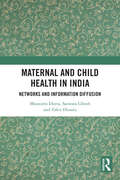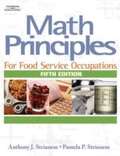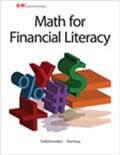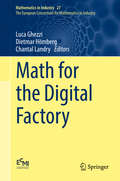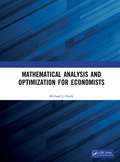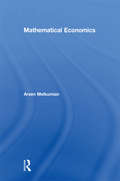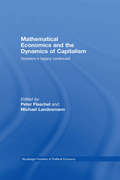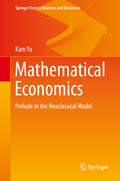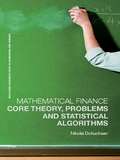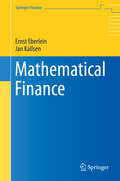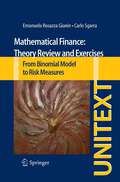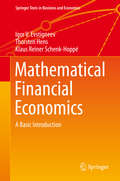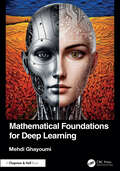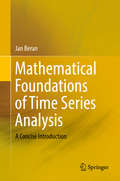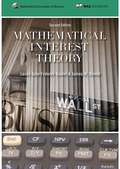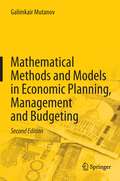- Table View
- List View
Materials Technology Corp.
by Clayton M. ChristensenMaterials Technology Corp. (MTC) is an MIT-based start-up company that identified an initial product market for its advanced materials-processing technology using conventional market research techniques. While pursuing that market--advanced microelectronic components--customers from very different markets such as steelmaking and electricians' hardware approach MTC, offering to pay MTC substantial money to develop and manufacture products for it. This calls into question MTC's initial market and product strategy.
Materials and Sustainability: Building a Circular Future
by Julia L Goldstein Paul Foulkes-ArellanoThis book examines sustainable manufacturing, from the extraction of materials to processing, use, and disposal, and argues that significant changes in all of the above are needed for the world to progress toward a more circular economy.Materials and processing methods are usually chosen with performance as the key metric. Why has our society embraced plastics? Because they work. In most cases, they are lighter, easier to manufacture, and less expensive than the metal, wood, glass, or stone they have replaced. Why do industrial manufacturers use toxic chemicals? Because they are effective, but the unintended consequences may be severe. By learning how various materials are made and what happens when they are recycled, readers will better understand the value of materials and the challenges that manufacturers face when trying to make their facilities and products less toxic and less wasteful. The three chapters in Part I provide essential background about materials in the circular economy, chemicals, and waste. Part II delves into specific materials. It includes chapters on plastics, metals, wood and paper products, glass, and novel materials. Part III covers recycling and manufacturing processes, and Part IV delves into practical considerations, including the effect of regulations, concluding with a chapter that helps readers translate the information presented into action. Interviews with industry experts round out the chapters and offer valuable insights.Materials and Sustainability is a must-read for business professionals who are serious about making their companies as environmentally responsible as possible and for business and engineering students who want to begin their careers with practical knowledge about materials and their impacts.
Materials in Energy Conversion, Harvesting, and Storage
by Kathy LuFirst authored book to address materials' role in the quest for the next generation of energy materials Energy balance, efficiency, sustainability, and so on, are some of many facets of energy challenges covered in current research. However, there has not been a monograph that directly covers a spectrum of materials issues in the context of energy conversion, harvesting and storage. Addressing one of the most pressing problems of our time, Materials in Energy Conversion, Harvesting, and Storage illuminates the roles and performance requirements of materials in energy and demonstrates why energy materials are as critical and far-reaching as energy itself. Each chapter starts out by explaining the role of a specific energy process in today's energy landscape, followed by explanation of the fundamental energy conversion, harvesting, and storage processes. Well-researched and coherently written, Materials in Energy Conversion, Harvesting, and Storage covers: The availability, accessibility, and affordability of different energy sources Energy production processes involving material uses and performance requirements in fossil, nuclear, solar, bio, wind, hydrothermal, geothermal, and ocean energy systems Issues of materials science in energy conversion systems Issues of energy harvesting and storage (including hydrogen storage) and materials needs Throughout the book, illustrations and images clarify and simplify core concepts, techniques, and processes. References at the end of each chapter serve as a gateway to the primary literature in the field. All chapters are self-contained units, enabling instructors to easily adapt this book for coursework. This book is suitable for students and professors in science and engineering who look to obtain comprehensive understanding of different energy processes and materials issues. In setting forth the latest advances and new frontiers of research, experienced materials researchers and engineers can utilize it as a comprehensive energy material reference book.
Maternal and Child Health in India: Networks and Information Diffusion
by Zakir Husain Mousumi Dutta Saswata GhoshThis book examines the process of information diffusion and the challenges of spreading awareness about maternal and child health (MCH) outcomes in India, with a special focus on Bihar – a state in eastern India.Investing in the health of women and children results in significant and long-lasting economic and social benefits to society. Analysing the National Family Health Survey data, the volume explores the role that access to information has on the adoption of MCH practices. It also explores regional variations – between Empowered Action Group (EAG) states and non-EAG states and also across EAG states – in the impact of information networks. Using appropriate econometric methods, the authors study the role of peer effects and grass-roots health workers in bringing about a change in attitude within communities. The book looks at the process of information dissemination between the grass-roots health workers and the target women and brings to the forefront the intricacies of patriarchal family dynamics that hinder women from accessing basic maternal and child healthcare needs. Based on grass-roots experiences, the book provides sharp insights from the field for the benefit of researchers, policymakers, and activists.Rich in empirical data, this book will be of interest to academics and researchers of development economics, public health policy and practice, community health, healthcare administration and management, primary healthcare and family practice, and health and social care.
Maternity Policy and the Making of the Norwegian Welfare State, 1880-1940
by Anna M. PetersonThis book traces women’s influence on maternity policy in Norway from 1880-1940. Maternity policies, including maternity leave, midwifery services and public assistance for mothers, were some of the first welfare policies enacted in Norway. Feminists, midwives, and working women participated in their creation and helped transform maternity policies from a restriction to a benefit. Situating Norway within the larger European context, the book contributes to discussions of Scandinavian welfare state development and further untangles the relationship between social policy and gender equality.The study of poor, rural women alongside urban middle-class feminists is rooted in an inclusive archival source base that speaks to the interplay between local and national welfare officials and recipients, the development and implementation of laws in diverse settings, the divergent effects maternity policies had on women, and women’s varied response.
Math Principles for Food Service Occupations (Fifth Edition)
by Anthony J. Strianese Pamela P. StrianeseMath Principles for Food Service Occupations teaches students that the understanding and application of mathematics is critical for all food service jobs, from entry level to executive chef or food service manager. All the mathematical problems and concepts presented are explained in a simplified, logical, step by step manner. Now out in the 5th edition, this text is unique because it follows a logical step-by-step process to illustrate and demonstrate the importance of understanding and using math concepts to effectively make money in this demanding business. Part 1 trains the student to use the calculator, while Part 2 reviews basic math fundamentals. Subsequent parts address math essentials in food preparation and math essentials in food service record keeping while the last part of the book concentrates on managerial math. Learning objectives and key words have also been expanded and added at the beginning of each chapter to identify key information, and case studies have been added to help students understand why knowledge of math can solve problems in the food service industry. The content meets the required knowledge and competencies for business and math skills as required by the American Culinary Federation.
Math Tools For Journalists: Professor/Professional Version
by Kathleen Woodruff WickhamCovers common math concepts such as percentages, statistics, business math, property taxes, polls/surveys, probability, and stocks and bonds.
Math for Financial Literacy
by Todd Knowlton Paul Gray Jr.This book prepares your students for the real world. Written specifically for teens, Math for Financial Literacy provides instruction for relevant math concepts that students can easily relate to their daily lives. <p><p> In Math for Financial Literacy, students learn how to apply basic math concepts to the tasks they will use in the real world, including earning a paycheck, managing a bank account, using credit cards, and creating a budget. Other practical topics are presented to help students become financially capable and responsible. Each chapter is designed to present content in small segments for optimal comprehension.
Math for Strategists
by Tarun Khanna Jan W. RivkinGreat strategists rely heavily on numbers as they go about their work. Offers an overview of the high- and low-brow quantitative tools that students encounter during the Strategy course. The class explores high-brow tools in detail; the focus here is on low-brow calculations. Such calculations come up often in class but because they seem so simple, they get little airtime or explanation. From past class experience, roughly 20% of the students in each section come into the course with the intuition and experience to do these simple calculations themselves. The other 80% understand the calculations after they see them and grasp their value, but don't spot the opportunities to do the math themselves, before class.
Math for the Digital Factory
by Luca Ghezzi Dietmar Hömberg Chantal LandryThis volume provides a unique collection of mathematical tools and industrial case studies in digital manufacturing. It addresses various topics, ranging from models of single production technologies, production lines, logistics and workflows to models and optimization strategies for energy consumption in production. The digital factory represents a network of digital models and simulation and 3D visualization methods for the holistic planning, realization, control and ongoing improvement of all factory processes related to a specific product. In the past ten years, all industrialized countries have launched initiatives to realize this vision, sometimes also referred to as Industry 4. 0 (in Europe) or Smart Manufacturing (in the United States). Its main goals are * reconfigurable, adaptive and evolving factories capable of small-scale production * high-performance production, combining flexibility, productivity, precision and zero defects * energy and resource efficiency in manufacturing None of these goals can be achieved without a thorough modeling of all aspects of manufacturing together with a multi-scale simulation and optimization of process chains; in other words, without mathematics. To foster collaboration between mathematics and industry in this area the European Consortium for Mathematics in Industry (ECMI) founded a special interest group on Math for the Digital Factory (M4DiFa). This book compiles a selection of review papers from the M4DiFa kick-off meeting held at the Weierstrass Institute for Applied Analysis and Stochastics in Berlin, Germany, in May 2014. The workshop aimed at bringing together mathematicians working on modeling, simulation and optimization with researchers and practitioners from the manufacturing industry to develop a holistic mathematical view on digital manufacturing. This book is of interest to practitioners from industry who want to learn about important mathematical concepts, as well as to scientists who want to find out about an exciting new area of application that is of vital importance for today's highly industrialized and high-wage countries.
Math for the World of Work
by Kathleen M. HarmeyerPlan a business-oriented curriculum for your students with this full-color, easy-to-read text that focuses on the skills students need on the job. Math for the World of Work covers critical skills like whole numbers, fractions, decimals, averages, estimating, measurements, and ratios. Each skill is introduced in a cross-curricular context that helps students learn about the business world. Lessons are reinforced with problem-solving activities, exercises, and review questions to give students plenty of practice and solidify their understanding of new skills. And features like Application Activities and Technology Connections ensure that students understand how to apply the skills they acquire.
Mathematical Analysis and Optimization for Economists
by Michael J. PanikIn Mathematical Analysis and Optimization for Economists, the author aims to introduce students of economics to the power and versatility of traditional as well as contemporary methodologies in mathematics and optimization theory; and, illustrates how these techniques can be applied in solving microeconomic problems. This book combines the areas of intermediate to advanced mathematics, optimization, and microeconomic decision making, and is suitable for advanced undergraduates and first-year graduate students. This text is highly readable, with all concepts fully defined, and contains numerous detailed example problems in both mathematics and microeconomic applications. Each section contains some standard, as well as more thoughtful and challenging, exercises. Solutions can be downloaded from the CRC Press website. All solutions are detailed and complete. Features Contains a whole spectrum of modern applicable mathematical techniques, many of which are not found in other books of this type. Comprehensive and contains numerous and detailed example problems in both mathematics and economic analysis. Suitable for economists and economics students with only a minimal mathematical background. Classroom-tested over the years when the author was actively teaching at the University of Hartford. Serves as a beginner text in optimization for applied mathematics students. Accompanied by several electronic chapters on linear algebra and matrix theory, nonsmooth optimization, economic efficiency, and distance functions available for free on www.routledge.com/9780367759018.
Mathematical Economics
by Arsen MelkumianThis textbook, designed for a single semester course, begins with basic set theory, and moves briskly through fundamental, exponential, and logarithmic functions. Limits and derivatives finish the preparation for economic applications, which are introduced in chapters on univariate functions, matrix algebra, and the constrained and unconstrained optimization of univariate and multivariate functions. The text finishes with chapters on integrals, the mathematics of finance, complex numbers, and differential and difference equations. Rich in targeted examples and explanations, Mathematical Economics offers the utility of a handbook and the thorough treatment of a text. While the typical economics text is written for two semester applications, this text is focused on the essentials. Instructors and students are given the concepts in conjunction with specific examples and their solutions.
Mathematical Economics and the Dynamics of Capitalism: Goodwin's Legacy Continued (Routledge Frontiers of Political Economy)
by Peter Flaschel Michael LandesmannRichard Goodwin was a pioneer in the use of mathematical tools to understand the dynamics of capitalist economies. This book contains contributions which focus on the rigorous extension of Goodwin’s modelling of macro-dynamics and the micro-structures underlying them, and also research with a wider perspective related to Goodwin’s vision of an integrated Marx-Keynes-Schumpeter (M-K-S) system of the dynamics of capitalist economies.The variety of approaches in this book range from detailed business cycle analyses to Schumpeterian processes of creative destruction. They include thorough theoretical analysis of delayed dynamical systems. empirical studies of Goodwin’s classical growth cycle model and the integration of Keynesian aspects of effective demand and of financial mechanisms that impact the real macro-economy. micro-economic structural analysis. expectations driven aspects of micro-founded business cycle modelling
Mathematical Economics: Prelude to the Neoclassical Model (Springer Texts in Business and Economics)
by Kam YuThis textbook provides a one-semester introduction to mathematical economics for first year graduate and senior undergraduate students. Intended to fill the gap between typical liberal arts curriculum and the rigorous mathematical modeling of graduate study in economics, this text provides a concise introduction to the mathematics needed for core microeconomics, macroeconomics, and econometrics courses. Chapters 1 through 5 builds students’ skills in formal proof, axiomatic treatment of linear algebra, and elementary vector differentiation. Chapters 6 and 7 present the basic tools needed for microeconomic analysis. Chapter 8 provides a quick introduction to (or review of) probability theory. Chapter 9 introduces dynamic modeling, applicable in advanced macroeconomics courses. The materials assume prerequisites in undergraduate calculus and linear algebra. Each chapter includes in-text exercises and a solutions manual, making this text ideal for self-study.
Mathematical Finance: Core Theory, Problems and Statistical Algorithms
by Nikolai DokuchaevWritten in a rigorous yet logical and easy to use style, spanning a range of disciplines, including business, mathematics, finance and economics, this comprehensive textbook offers a systematic, self-sufficient yet concise presentation of the main topics and related parts of stochastic analysis and statistical finance that are covered in the majority of university programmes. Providing all explanations of basic concepts and results with proofs and numerous examples and problems, it includes: an introduction to probability theory a detailed study of discrete and continuous time market models a comprehensive review of Ito calculus and statistical methods as a basis for statistical estimation of models for pricing a detailed discussion of options and their pricing, including American options in a continuous time setting. An excellent introduction to the topic, this textbook is an essential resource for all students on undergraduate and postgraduate courses and advanced degree programs in econometrics, finance, applied mathematics and mathematical modelling as well as academics and practitioners.
Mathematical Finance: In Honour Of Ernst Eberlein (Springer Finance #189)
by Jan Kallsen Ernst EberleinTaking continuous-time stochastic processes allowing for jumps as its starting and focal point, this book provides an accessible introduction to the stochastic calculus and control of semimartingales and explains the basic concepts of Mathematical Finance such as arbitrage theory, hedging, valuation principles, portfolio choice, and term structure modelling. It bridges thegap between introductory texts and the advanced literature in the field.Most textbooks on the subject are limited to diffusion-type models which cannot easily account for sudden price movements. Such abrupt changes, however, can often be observed in real markets. At the same time, purely discontinuous processes lead to a much wider variety of flexible and tractable models. This explains why processes with jumps have become an established tool in the statistics and mathematics of finance. Graduate students, researchers as well as practitioners will benefit from this monograph.
Mathematical Finance: Theory Review and Exercises
by Emanuela Rosazza Gianin Carlo SgarraThe book collects over 120 exercises on different subjects of Mathematical Finance, including Option Pricing, Risk Theory, and Interest Rate Models. Many of the exercises are solved, while others are only proposed. Every chapter contains an introductory section illustrating the main theoretical results necessary to solve the exercises. The book isintended as an exercise textbook to accompany graduate courses in mathematical finance offered at many universities as part of degree programs in Applied and Industrial Mathematics, Mathematical Engineering, and Quantitative Finance.
Mathematical Financial Economics
by Igor V. Evstigneev Thorsten Hens Klaus Reiner Schenk-HoppéThis textbook is an elementary introduction to the key topics in mathematical finance and financial economics - two realms of ideas that substantially overlap but are often treated separately from each other. Our goal is to present the highlights in the field, with the emphasis on the financial and economic content of the models, concepts and results. The book provides a novel, unified treatment of the subject by deriving each topic from common fundamental principles and showing the interrelations between the key themes. Although the presentation is fully rigorous, with some rare and clearly marked exceptions, the book restricts itself to the use of only elementary mathematical concepts and techniques. No advanced mathematics (such as stochastic calculus) is used.
Mathematical Foundations for Deep Learning
by Mehdi GhayoumiMathematical Foundations for Deep Learning bridges the gap between theoretical mathematics and practical applications in artificial intelligence (AI). This guide delves into the fundamental mathematical concepts that power modern deep learning, equipping readers with the tools and knowledge needed to excel in the rapidly evolving field of artificial intelligence.Designed for learners at all levels, from beginners to experts, the book makes mathematical ideas accessible through clear explanations, real-world examples, and targeted exercises. Readers will master core concepts in linear algebra, calculus, and optimization techniques; understand the mechanics of deep learning models; and apply theory to practice using frameworks like TensorFlow and PyTorch.By integrating theory with practical application, Mathematical Foundations for Deep Learning prepares you to navigate the complexities of AI confidently. Whether you’re aiming to develop practical skills for AI projects, advance to emerging trends in deep learning, or lay a strong foundation for future studies, this book serves as an indispensable resource for achieving proficiency in the field.Embark on an enlightening journey that fosters critical thinking and continuous learning. Invest in your future with a solid mathematical base, reinforced by case studies and applications that bring theory to life, and gain insights into the future of deep learning.
Mathematical Foundations of Time Series Analysis: A Concise Introduction
by Jan BeranThis book provides a concise introduction to the mathematical foundations of time series analysis, with an emphasis on mathematical clarity. The text is reduced to the essential logical core, mostly using the symbolic language of mathematics, thus enabling readers to very quickly grasp the essential reasoning behind time series analysis. It appeals to anybody wanting to understand time series in a precise, mathematical manner. It is suitable for graduate courses in time series analysis but is equally useful as a reference work for students and researchers alike.
Mathematical Interest Theory (Maa Textbooks)
by James W. Daniel Leslie Jane Federer VaalerMathematical Interest Theory gives an introduction to how investments grow over time in a mathematically precise manner. The emphasis is on practical applications that give the reader a concrete understanding of why the various relationships should be true. Among the modern financial topics introduced are: arbitrage, options, futures, and swaps. The content of the book, along with an understanding of probability, will provide a solid foundation for readers embarking on actuarial careers.Mathematical Interest Theory includes more than 240 carefully worked examples. There are over 430 problems, and numerical answers are included in an appendix. A companion student solution manual has detailed solutions to the odd-numbered problems. Key Features • Detailed instruction on how to use the Texas Instruments BA II Plus and BA II Plus professional calculators. • Examples are worked out with the problem and solution delineated so that the reader can think about the problem before reading the solution presented in the text • Key formulas, facts and algorithms placed in boxes so that they stand out in the text, and new terms printed in boldface as they are introduced • Descriptive titles are given for the examples in the book,( i.e., “Finding a(t) from ?t” or “Finding a bond's yield rate” )to help students skimming the book quickly find relevant material.• Exercises feature applied financial questions, • Writing activities for each chapter introduce each homework set.
Mathematical Methods and Models for Economists
by Angel de la FuenteThis book is intended as a textbook for a first-year Ph. D. course in mathematics for economists and as a reference for graduate students in economics. It provides a self-contained, rigorous treatment of most of the concepts and techniques required to follow the standard first-year theory sequence in micro and macroeconomics. The topics covered include an introduction to analysis in metric spaces, differential calculus, comparative statics, convexity, static optimization, dynamical systems and dynamic optimization. The book includes a large number of applications to standard economic models and over two hundred fully worked-out problems.
Mathematical Methods and Models in Economic Planning, Management and Budgeting
by Galimkair MutanovThis book describes a system of mathematical models and methods that can be used to analyze real economic and managerial decisions and to improve their effectiveness. Application areas include: management of development and operation budgets, assessment and management of economic systems using an energy entropy approach, equation of exchange rates and forecasting foreign exchange operations, evaluation of innovative projects, monitoring of governmental programs, risk management of investment processes, decisions on the allocation of resources, and identification of competitive industrial clusters. The proposed methods and models were tested on the example of Kazakhstan's economy, but the generated solutions will be useful for applications at other levels and in other countries. Regarding your book "Mathematical Methods and Models in Economics", I am impressed because now it is time when "econometrics" is becoming more appreciated by economists and by schools that are the hosts or employers of modern economists. . . . Your presented results really impressed me. John F. Nash, Jr. , Princeton University, Nobel Memorial Prize in Economic Sciences The book is within my scope of interest because of its novelty and practicality. First, there is a need for realistic modeling of complex systems, both natural and artificial that conclude computer and economic systems. There has been an ongoing effort in developing models dealing with complexity and incomplete knowledge. Consequently, it is clear to recognize the contribution of Mutanov to encapsulate economic modeling with emphasis on budgeting and innovation. Secondly, the method proposed by Mutanov has been verified by applying to the case of the Republic of Kazakhstan, with her vibrant emerging economy. Thirdly, Chapter 5 of the book is of particular interest for the computer technology community because it deals with innovation. In summary, the book of Mutanov should become one of the outstanding recognized pragmatic guides for dealing with innovative systems. Andrzej Rucinski, University of New Hampshire This book is unique in its theoretical findings and practical applicability. The book is an illuminating study based on an applied mathematical model which uses methods such as linear programming and input-output analysis. Moreover, this work demonstrates the author's great insight and academic brilliance in the fields of finance, technological innovations and marketing vis-à-vis the market economy. From both theoretical and practical standpoint, this work is indeed a great achievement. Yeon Cheon Oh, President of Seoul National University



